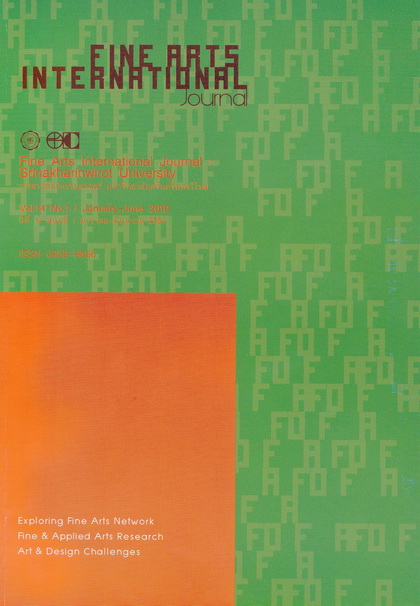An Analytical Study of Ikat Cloths of Thai Puan Living in Bann Mee, Lopburi Province
Abstract
This is an analytical study of Ikat cloths of Thai Puan people living in Lopburi province in terms of production process, design, color, product processing and wisdom transfer. The data from three major groups of producers including “Bann Puan Group” located in Tumbon Hinpak, “Bann Gluay Group” located in Tumbon Bann Gluay, and “Aunt Narong Center” located in Tumbon Bann Sai was compared. Sample groups were Ikat cloths form three producers, one hundred cloths each.
Production process of Thai Puan people living in Bann Mee, Lopburi province included 3 major factors which were 1) thread preparation and weave process, 2) materials, and 3) equipments. Thread preparation and weave process could be divided into two periods, former and present time. There were differences between the two periods in terms of process details, time spent, materials and equipment used. In the past, each craftsman had to complete all processes ranging from thread preparation to weaving to produce the cloth. Presently, the craftsman needs not to complete all steps since there are groups of people who perform specific work to serve weave process. Therefore, time taken in the process is shorter than it was in the past.
The designs of cloths from the three producers could be divided into two groups including basic or ancient design and developed or applied design. Names of basic or ancient design from three groups of producers could be classified as nineteen groups including Kra Chab, Kha Yum Teen Ma, Kha Pia, Khao LhamTud, Ta Khai, Bua Kwam Bua Ngai, Plong Oiy, Mha Tum, Mee Khor, Mee Khun, Mee Kope, Mee Nak, Mee Bua Krue, Mee Piang, Mee Yoi, Mee Lai, and Mee Iang Song Klong. It was found that Mha Tum was the most popular design found in Bann Puan and Bann Gluay Groups. For Aunt Narong Center, Mee Lai was the most popular design.
For developed or applied designs, they could be classified into four groups as designs developed from basic or ancient ones i.e. Khun Chae Lock, Khum Sub Noi, Cherng Thien, Pan Kruea, Pan Lak, Applied Pan Lak, Applied Mha Tum, Applied Mha Mui, Applied Mee, Mee Lock, Comb Tung, Jaekun Kaew, Kra Chome, Kunjae, Kiew Koi Nong Nang, Kor Kamen, Kor Bet, Kor Pra Thep, Khum Sub, Kruang Bin, Khae Ma, Dok Khaosan, Dao Lom Duen, Man Sonthaya, Si Trakraw, Na Tang, Mee Pan Kruea and Liam, design developed from animals i.e. Kham Poo, Khai, Nok Yoong, Nok Yoong Rum Pan, Pee Sua, Hong, Hoi Khong, Tao, Pla Muk, Ma Num, Mang Mum and Hang Nok Yoong, designs developed from plants i.e. Dok Tan Tawan, Ton Son, Chor Paka, Dok Phikul and Mafueang, and designs developed from geometric shapes i.e. Kra Dook, Reka Kanit, Scot, Sai Roong, Khanom Piakpoon and Sao. The popularity for producing cloths with developed or applied designs varied between the three producers. This was the result of variation of designs and colors initiated by craftsmen in each groups and reflected consumer demand.
Colors used in cloths from the three groups could be divided into three types including tone, shading and contrast. The result showed that most of basic or ancient design cloths’ colors were not dim but rather warm toned.
Products developed from Ikat cloths could be classified into ten groups including pillow slip, pillow, scarf, dress, suit, local dress, purse, pouch, key ring, and slippers. In addition, styles of the products were similar among groups of producers. This revealed the similarity of communities’ lives, ideas and opinion sharing among the neighboring communities.
Wisdom was transferred from the old to the new generation and similarly found in all three producers. The process of wisdom transfer included learning by doing, being familiar with craftsmen’s life to obtain knowledge, being of assistance to the craftsmen, and living in real environment in order to be inspired. These learning processes are still generally seen today.






